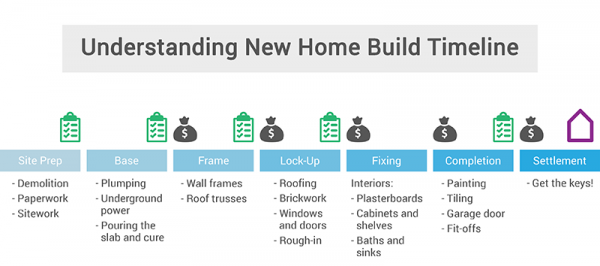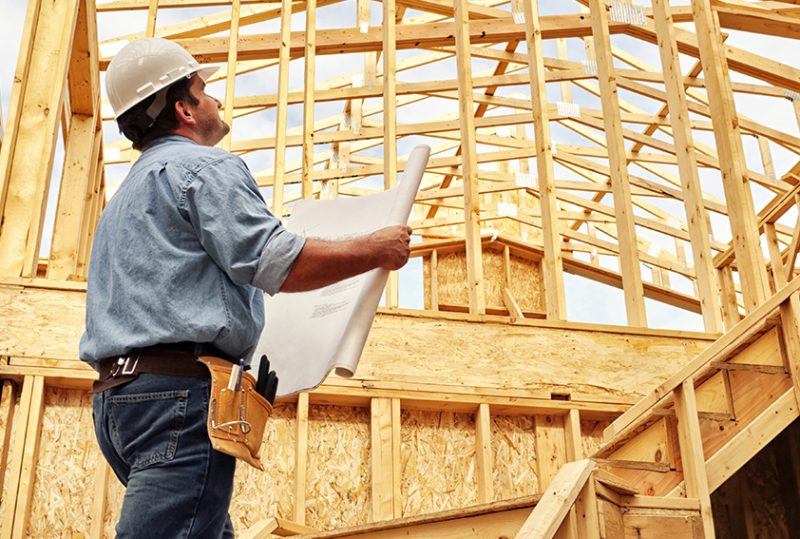You’ve gone through the process of visiting display homes, choosing the right design, and signed the contract – it’s finally time for your new home build. A new home build will require 6 – 12 months (subject to a range of factors) to complete, with a set sequence of stages that take place. Understanding the timeline will help you keep track of the progress and know what’s required of you throughout the construction.

1. New Home Build Site Preparation
Demolition – If you are going for a knock-down rebuild, you will obviously need to remove all existing structures on your site – foundation, footings, paving, etc. Not all volume home builders will arrange the demolition for you, but they will be able to recommend reputable companies who can. Through your demolition contractor, you will need to organise a demolition permit from the local council.
Paperwork – Before you start building, you will need to do a feature survey and soil test for your block of land. These services are usually covered as part of your building contract. The feature survey is a scale drawing of your home site showing the fall of the land, service connection points, easements, and any pre-existing features. Soil testing determines the ‘reactivity’ of your soil.
For a knock-down rebuild, you are required to do the soil test and feature survey before the demolition, and then again after. Upon completion, you will also need an independent, licenced asbestos assessor to verify that the site is free of asbestos, which you will be issued with an Asbestos Clearance Certificate.
Sitework – Prepare your land for site start based on your new home builder’s requirements, e.g. get the demolishers to remove all debris and rubble, cut down the grass and weeds. Then it all begins and your land will be excavated in preparation for the concrete slab to be poured. Your builder should send you a written notification that your new home build has commenced.
✓ Building Inspection #1 – Footings. Mandatory inspections are carried out at various stages of the construction period to prevent major issues that may arise in the future. At each stage, the building surveyor must legally sign off the work that has been done by the builder before the next stage can continue. At this point, the building surveyor will inspect the excavation work, boundary clearances, and reinforcements before placing your house’s footings.
2. Foundation/Base Stage
Initial works for underground power and plumbing are put in during this stage.
✓ Building Inspection #2 – Slab/Base. Inspection is conducted before the concrete base is poured and allowed to dry. Aspects of this stage include floor level check, termite treatment, etc.
The slab is then poured and will then need time to ‘cure’.
? First Progress Payment Due. Progress payments will be due upon completion of each building stage. Your first payment usually takes place when the base stage is completed. The percentage to be paid in each stage varies depending on the specific contract with your builder, check the payment schedule outlined in your building contract.
3. Frame Stage
The house starts taking shape as carpenters erect wall frames and roof trusses.
✓ Building Inspection #3 – Frame. Checking that the dimensions and placements of the frame conform to the approved plans, and ensure tie down straps to the slab are correctly installed.
? Second Progress Payment Due.
4. Lock-up Stage
Getting the home to a point where it can be ‘locked-up’ with a roof and walls. Fascia, guttering and the roof covering are done, followed by brickwork and external cladding. Windows and external doors will also be installed. Once the cladding has gone on (or while it is going on), plumbers and electricians will ‘rough in’ necessary piping, cabling and fittings. This means to bring in the various lines (plumbing pipes, ducting, electrical conduit) to the house, without making the final connections.
✓ Building Inspection #4 – Waterproofing. Currently only mandatory in QLD and NSW, this includes inspection of roofing, waterproofing, plumbing and windows.
? Third Progress Payment Due.
5. Fixing Stage
Moving on to the interior of the homes, with all the features being fitted. Plasterboard is installed to walls and ceilings; internal doors, cabinets and shelves all go in, as well as skirting boards and architraves. Baths, basins and sinks also appear during this phase; and if it’s a double storey, stairs are added at this point as well.
? Fourth Progress Payment Due.
6. Completion Stage
The last phase of readying the home for you to move into it. Painting and tiling is finished, likewise any external render and the garage doors are installed. Electrical and plumbing fit-offs, benchtops, shower screens and mirrors are all installed. Once this is all done, your builder will arrange for you to be walked through your new home and confirm a handover date with you.
✓ Building Inspection #5 – Final. A throughout inspection checking off on all areas of your completed house according to the building code. The building surveyor will issue a Certificate of Occupancy.
It is not up to the surveyors to judge the quality of your builder’s workmanship, so you should do a double check that everything is working and looking the way they should. Any defects must be highlighted to the builder to be fixed. If you are not feeling confident, you may consider engaging an independent building consultant.
? Final Progress Payment Due. Once you receive the Certificate of Occupancy and the final invoice from the builder, forward those to your bank or lender. In most cases the bank will send a valuer out to the property to inspect the completion of the works before releasing the funds.
7. Settlement
The day you’ve been waiting for when you complete payments and get the keys! Volume builders offer a maintenance period (of varying lengths), which cover any defects in the period after settlement. Discuss with your builder how this process works.
As always, confirm the exact stages, time frames and processes with your builder, as there may be some slight variations. By educating yourself early and understanding the new home build process upfront, you can make the experience a more enjoyable one.

Related Articles:
Infographic: Getting the most from your builder
4 Construction Trends You Need To Know
The questions you wished you’d asked your builder

- We’ll ask the right questions to better understand your needs
- We’ll create a recommended shortlist ideally matched to you
- We’ll answer specific questions or concerns related to home building, land purchasing or financing













